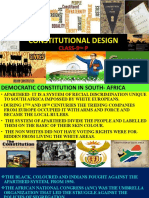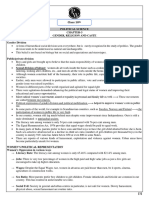0 ratings0% found this document useful (0 votes)
Indipendent India
Indipendent India
Uploaded by
SAI PRANEETH REDDY DHADIThe document summarizes key aspects of India's first general elections held in 1952 after independence:
1) India adopted universal adult suffrage, extending voting rights to all citizens unlike many Western democracies which did so gradually. Novel methods like electoral symbols helped overcome issues of illiteracy.
2) The elections saw massive voter turnout and some unique local practices to encourage voting. Congress won a majority, starting a period of dominant one-party rule though internal factions ensured debate.
3) The early post-independence period focused on maintaining unity, transforming society and economy, and ensuring democracy worked, laying the foundation for a stable multiparty system despite Congress' early dominance.
Copyright:
© All Rights Reserved
Available Formats
Download as PDF, TXT or read online from Scribd
Download as pdf or txt
Indipendent India
Indipendent India
Uploaded by
SAI PRANEETH REDDY DHADI0 ratings0% found this document useful (0 votes)
The document summarizes key aspects of India's first general elections held in 1952 after independence:
1) India adopted universal adult suffrage, extending voting rights to all citizens unlike many Western democracies which did so gradually. Novel methods like electoral symbols helped overcome issues of illiteracy.
2) The elections saw massive voter turnout and some unique local practices to encourage voting. Congress won a majority, starting a period of dominant one-party rule though internal factions ensured debate.
3) The early post-independence period focused on maintaining unity, transforming society and economy, and ensuring democracy worked, laying the foundation for a stable multiparty system despite Congress' early dominance.
Copyright
© © All Rights Reserved
Available Formats
PDF, TXT or read online from Scribd
Share this document
Did you find this document useful?
Is this content inappropriate?
The document summarizes key aspects of India's first general elections held in 1952 after independence:
1) India adopted universal adult suffrage, extending voting rights to all citizens unlike many Western democracies which did so gradually. Novel methods like electoral symbols helped overcome issues of illiteracy.
2) The elections saw massive voter turnout and some unique local practices to encourage voting. Congress won a majority, starting a period of dominant one-party rule though internal factions ensured debate.
3) The early post-independence period focused on maintaining unity, transforming society and economy, and ensuring democracy worked, laying the foundation for a stable multiparty system despite Congress' early dominance.
Copyright:
© All Rights Reserved
Available Formats
Download as PDF, TXT or read online from Scribd
Download as pdf or txt
0 ratings0% found this document useful (0 votes)
Indipendent India
Indipendent India
Uploaded by
SAI PRANEETH REDDY DHADIThe document summarizes key aspects of India's first general elections held in 1952 after independence:
1) India adopted universal adult suffrage, extending voting rights to all citizens unlike many Western democracies which did so gradually. Novel methods like electoral symbols helped overcome issues of illiteracy.
2) The elections saw massive voter turnout and some unique local practices to encourage voting. Congress won a majority, starting a period of dominant one-party rule though internal factions ensured debate.
3) The early post-independence period focused on maintaining unity, transforming society and economy, and ensuring democracy worked, laying the foundation for a stable multiparty system despite Congress' early dominance.
Copyright:
© All Rights Reserved
Available Formats
Download as PDF, TXT or read online from Scribd
Download as pdf or txt
You are on page 1/ 5
Introduction
• On the 26th of January 1950, we are going to enter into a life
of contradictions.In politics we will have equality and in
social and economic life we will have inequality.In politics we
will be recognising the principle of one man one vote and one
vote one value.In our social and economic life, we shall, by
reason of our social and economic structure, continue to deny
the principle of one man one value.How long shall we
continue to live this life of contradictions? How long shall we
continue to deny equality in our social and economic life? If
we continue to deny it for long,we will do so only by putting
our political democracy in peril.We must remove this
contradiction at the earliest possible moment or else those
who suffer from inequality will blow up the structure of
political democracy which this Assembly has so laboriously
built up.
• - B R Ambedkar
• The Constitution sought to fulfil multiple goals simultaneously,
including making democracy work,unification and creation of a
single political community and bringing about massive social
and economic changes.
• The setting of national goals and putting in place institutional
mechanisms to achieve them within a relatively short span of
time was undoubtedly a great achievement for a people who
had been ruled by foreign power for more than two centuries.
• The early years after independence,is arguably the defining
period in India’s post-independent history.
• The main challenges before the leadership was the need to
maintain unity and integrity, bring about a social and economic
transformation and to ensure the working of the democratic
system.
• These challenges are interrelated and great care had to be
taken to ensure that the system did not get imbalanced.For
instance, development goals and unity and integrity should not
come at the cost of democracy.
First General Elections
• The first general elections to be held under the new Constitution
were immensely significant for Indian democracy.
• It represented India’s determination to take the path of
democracy after independence from British rule.
• India adopted Universal Adult franchise at one go,unlike in the
West were franchise was extended in stages,first to the
propertied and only subsequently to other sections of society.
For instance women in Switzerland got the right to vote only in
1971.
Voting in first general elections
• To overcome the problem of illiteracy,the Election Commission
came up with a novel idea of having symbols from everyday life
to represent political parties and candidates.This creative
innovation dispensed with elaborate instructions and required
only visual identification.This basic idea continues even today.
• To make it even easier, in the first election each candidate had
a separate ballot box with the symbol stuck outside; the voter
only had to drop their ballot paper in the box of their preferred
candidate.In the run up to the elections, there was a massive
campaign to encourage the voters to go out and vote.
o Description of Elections
o In districts where purdah was strictly
observed,separate voting booths, staffed entirely by
women were usually provided.
o In Ajmer a Rajput woman arrived at the polls in a
heavily veiled chariot,her whole body was draped in
velvet.The only part she exposed to the public gaze was
the left forefinger which,as was required to prevent
repeated voting,she extended to be marked with
indelible ink.
o Some villages voted as body.From Assam came the
report of a tribal village whose members journeyed to
the polling station the day before voting was to take
place.They spent the night dancing and singing around
large bonfires until sun-up when they marched to the
booths in orderly fashion.
o The people of PEPSU village solved the problem of which
of the two rival candidates to support by arranging a
wrestling match between two of their young men,each
named to represent a candidate,having agreed that all
would vote for the candidate whose representative won.
o Many offerings were brought,petitions professing
loyalty or begging for food and clothing were sometimes
found when ballot boxes were opened.
o (Extracts from "The Indian Experience with Democratic
Elections" 1958 by Margaret W.Fisher and Joan
V.Bondurant,Indian Press Digests.)
• In Independent India’s first three general elections in
1952,1957 and 1962 the Indian National Congress won
reducing other participants to almost nothing.
• Jawaharlal Nehru became the first Prime Minister of India.None
of the other parties individually got more than 11% of the votes
polled.
• The Congress consistently won over 70% of the seats by
obtaining about 45% of the total votes cast.No other party was
anyway near the Congress.
• The Congress party formed the government in many of the
states as well.This inaugurated what some observers called the
Congress System.This period is identified specifically by the
nature of the relationship between the almost always ruling
Congress party and the other parties.However,the Congress
always had within it smaller groups. Though these groups
originated on the basis of personal competition between
leaders,they shared in the overall goals of the party but differed
on some policy issues.
• The groups took different positions on various issues depending
on the interests of the members. This made the Congress
appear as if it was a party representing diverse interests and
positions.
• At times,these groups also tied up with other political parties to
pressurise the leadership.This also acted as an inbuilt
corrective mechanism within the ruling party.
• Political competition in the one-party dominant system therefore
took place within the Congress.
• The opposition parties therefore only posed a latent and not a
real threat.
• It was therefore not an undemocratic situation marked by the
absence of other political parties.
• It was that the other parties which contested but were not able
to win enough seats to challenge the Congress.
• The other political parties gradually built themselves and within
a couple of decades became strong contenders for power.This
period to a large extent helped nurture democracy in its early
years allowing the establishment of a multi-party system based
on free and open competition.
• It was the strength of the Constitutional framework and the
democratic foundations laid by the freedom movement which
enabled Indian politics to develop a multiparty democracy.
• Ruling parties have often acted in a partisan manner to silence
the opposition and prevent multiparty democracy from striking
roots.
• India’s experience was therefore very different from that of
other colonial countries which got freedom around the same
time like Indonesia, Pakistan,China,Nigeria and so on.
You might also like
- Get (Ebook PDF) Canadian Democracy 9th Edition Free All Chapters57% (7)Get (Ebook PDF) Canadian Democracy 9th Edition Free All Chapters28 pages
- Old NCERT Books PDF Political Science Class XII Democracy in India Issues and Challenges - WWW - Dhyeyaias.com - PDFNo ratings yetOld NCERT Books PDF Political Science Class XII Democracy in India Issues and Challenges - WWW - Dhyeyaias.com - PDF285 pages
- 12 Political Science Era of One-Party Dominance - Notes67% (3)12 Political Science Era of One-Party Dominance - Notes6 pages
- Chapter 2 Era of One Party Dominance Class 12 Political Science Notes100% (1)Chapter 2 Era of One Party Dominance Class 12 Political Science Notes6 pages
- Direction of The Better Educated, More Wealthy and Advantaged Citizen)No ratings yetDirection of The Better Educated, More Wealthy and Advantaged Citizen)5 pages
- 3.20 - Post Independence History Part 3No ratings yet3.20 - Post Independence History Part 320 pages
- Congress and Other Political FormationsNo ratings yetCongress and Other Political Formations139 pages
- Class 12 NCERT Political Science (2) Chapter 2100% (1)Class 12 NCERT Political Science (2) Chapter 228 pages
- Democratic Politics Class IX: What Is Democracy? Why Democracy?No ratings yetDemocratic Politics Class IX: What Is Democracy? Why Democracy?24 pages
- CONSTITUTIONAL DESIGN - Class Notes - SprintNo ratings yetCONSTITUTIONAL DESIGN - Class Notes - Sprint73 pages
- Gender, Religion and Caste - Short NotesNo ratings yetGender, Religion and Caste - Short Notes4 pages
- GENDER, RELIGION AND CASTE EXTRA QUESTIONSNo ratings yetGENDER, RELIGION AND CASTE EXTRA QUESTIONS7 pages
- Chapter 10-Party and Party System in IndiaNo ratings yetChapter 10-Party and Party System in India9 pages
- Electoral Reform: Guided By: Mr. Kishore DereNo ratings yetElectoral Reform: Guided By: Mr. Kishore Dere14 pages
- Debate: Direct Democracy: From DebatepediaNo ratings yetDebate: Direct Democracy: From Debatepedia47 pages
- Chapter - 1 What Is Democracy Why DemocracyNo ratings yetChapter - 1 What Is Democracy Why Democracy19 pages
- CBSE Notes Class 10 Political Science (Civics) Chapter 4 - Gender, Religion and Caste100% (3)CBSE Notes Class 10 Political Science (Civics) Chapter 4 - Gender, Religion and Caste5 pages
- Ramanujan Institution O F Mathe Matics A N D Science: H.Chakradh ARNo ratings yetRamanujan Institution O F Mathe Matics A N D Science: H.Chakradh AR3 pages
- RAMANUJAN INSTITUTION OF MATHS AND SCIENCE (Biology Test - Grand)No ratings yetRAMANUJAN INSTITUTION OF MATHS AND SCIENCE (Biology Test - Grand)5 pages
- Class-9 Physical Science Notes: Ramanujan Institution of Mathematics and ScienceNo ratings yetClass-9 Physical Science Notes: Ramanujan Institution of Mathematics and Science6 pages
- 10CLASS ELECTROMAGNETISM at RIMS WNP TS SSCNo ratings yet10CLASS ELECTROMAGNETISM at RIMS WNP TS SSC19 pages
- Carbon and Its Compounds Lesson Notes TS SSCNo ratings yetCarbon and Its Compounds Lesson Notes TS SSC35 pages
- NCERT-Solutions-for-Class-9-SST-Civics-Chapter-3-Electoral-PoliticsNo ratings yetNCERT-Solutions-for-Class-9-SST-Civics-Chapter-3-Electoral-Politics7 pages
- Communications For Kulaman and BagumbayanNo ratings yetCommunications For Kulaman and Bagumbayan4 pages
- Ethnicity, and Censorship Among The Oromo of EthiopiaNo ratings yetEthnicity, and Censorship Among The Oromo of Ethiopia262 pages
- Order Finn V Cobb County Board ElectionsNo ratings yetOrder Finn V Cobb County Board Elections34 pages
- Mempertahankan Tatanan Regional Di Asia Tenggara: Keterbatasan Dan Opsi Indonesia (Indonesia Foreign Policy Review Vol 5)No ratings yetMempertahankan Tatanan Regional Di Asia Tenggara: Keterbatasan Dan Opsi Indonesia (Indonesia Foreign Policy Review Vol 5)16 pages
- SSC CGL Tier 1 Question Paper 21 April 2022 3rd Shift in EnglishNo ratings yetSSC CGL Tier 1 Question Paper 21 April 2022 3rd Shift in English32 pages
- Movie Review of "The Great Debaters" With Special Emphasis On Social Constructs in TexasNo ratings yetMovie Review of "The Great Debaters" With Special Emphasis On Social Constructs in Texas4 pages
- Watch and Learn: India'S Election SystemNo ratings yetWatch and Learn: India'S Election System4 pages
- The School of The Archdiocese of Capiz Roxas City Capiz Worksheet in MC 1 Semester A.Y. 2020-2021No ratings yetThe School of The Archdiocese of Capiz Roxas City Capiz Worksheet in MC 1 Semester A.Y. 2020-20215 pages
- REPRESENTATIVES FOR THE VARIOUS COMMITTEES FFNo ratings yetREPRESENTATIVES FOR THE VARIOUS COMMITTEES FF6 pages
- Revisi - 7a - Format Rapot Asesmen Tengah Semester GenapNo ratings yetRevisi - 7a - Format Rapot Asesmen Tengah Semester Genap9 pages
- Get (Ebook PDF) Canadian Democracy 9th Edition Free All ChaptersGet (Ebook PDF) Canadian Democracy 9th Edition Free All Chapters
- Old NCERT Books PDF Political Science Class XII Democracy in India Issues and Challenges - WWW - Dhyeyaias.com - PDFOld NCERT Books PDF Political Science Class XII Democracy in India Issues and Challenges - WWW - Dhyeyaias.com - PDF
- 12 Political Science Era of One-Party Dominance - Notes12 Political Science Era of One-Party Dominance - Notes
- Chapter 2 Era of One Party Dominance Class 12 Political Science NotesChapter 2 Era of One Party Dominance Class 12 Political Science Notes
- Direction of The Better Educated, More Wealthy and Advantaged Citizen)Direction of The Better Educated, More Wealthy and Advantaged Citizen)
- Democratic Politics Class IX: What Is Democracy? Why Democracy?Democratic Politics Class IX: What Is Democracy? Why Democracy?
- CBSE Notes Class 10 Political Science (Civics) Chapter 4 - Gender, Religion and CasteCBSE Notes Class 10 Political Science (Civics) Chapter 4 - Gender, Religion and Caste
- Every Vote Counts: The Story of India's ElectionsFrom EverandEvery Vote Counts: The Story of India's Elections
- Ramanujan Institution O F Mathe Matics A N D Science: H.Chakradh ARRamanujan Institution O F Mathe Matics A N D Science: H.Chakradh AR
- RAMANUJAN INSTITUTION OF MATHS AND SCIENCE (Biology Test - Grand)RAMANUJAN INSTITUTION OF MATHS AND SCIENCE (Biology Test - Grand)
- Class-9 Physical Science Notes: Ramanujan Institution of Mathematics and ScienceClass-9 Physical Science Notes: Ramanujan Institution of Mathematics and Science
- NCERT-Solutions-for-Class-9-SST-Civics-Chapter-3-Electoral-PoliticsNCERT-Solutions-for-Class-9-SST-Civics-Chapter-3-Electoral-Politics
- Ethnicity, and Censorship Among The Oromo of EthiopiaEthnicity, and Censorship Among The Oromo of Ethiopia
- Mempertahankan Tatanan Regional Di Asia Tenggara: Keterbatasan Dan Opsi Indonesia (Indonesia Foreign Policy Review Vol 5)Mempertahankan Tatanan Regional Di Asia Tenggara: Keterbatasan Dan Opsi Indonesia (Indonesia Foreign Policy Review Vol 5)
- SSC CGL Tier 1 Question Paper 21 April 2022 3rd Shift in EnglishSSC CGL Tier 1 Question Paper 21 April 2022 3rd Shift in English
- Movie Review of "The Great Debaters" With Special Emphasis On Social Constructs in TexasMovie Review of "The Great Debaters" With Special Emphasis On Social Constructs in Texas
- The School of The Archdiocese of Capiz Roxas City Capiz Worksheet in MC 1 Semester A.Y. 2020-2021The School of The Archdiocese of Capiz Roxas City Capiz Worksheet in MC 1 Semester A.Y. 2020-2021
- Revisi - 7a - Format Rapot Asesmen Tengah Semester GenapRevisi - 7a - Format Rapot Asesmen Tengah Semester Genap





































































































